Seat Ateca 2017 User Guide
Manufacturer: SEAT, Model Year: 2017, Model line: Ateca, Model: Seat Ateca 2017Pages: 328, PDF Size: 6.36 MB
Page 11 of 328

The essentials
How it works
Un loc
king and locking
Doors Fig. 1
Remote control key: buttons. Fig. 2
Driver door: central locking switch. Locking and unlocking the vehicle using the
k
ey
● L
ocking: press the ››
› Fig. 1 button.
● Locking the vehicle without activating the
anti-theft
system: Press the ››› Fig. 1 button
for a second time within 2 seconds.
● Unlocking: press the ››
› Fig. 1 button.
● Unlocking the rear lid: Hold down the
››
› Fig. 1 button for at least 1 second.
Locking and unlocking with the central lock-
ing switch
● Locking: press the ››
› Fig. 2 button. None
of the doors can be opened from the outside.
The doors can be opened from the inside by
pulling the inside door handle.
● Unlocking: press the ››
› Fig. 2 button.
››› in Description on page 112
››› page 112
››› page 9, ››› page 10 Unlocking and locking the driver's
door
Fig. 3
Driver door lever: hidden lock cylinder. If the central locking system should fail to op-
er
at
e, the driver door can still be locked and
unlocked by turning the key in the lock.
As a general rule, when the driver door is
locked manually all other doors are locked.
When it is unlocked manually, only the driver
door opens. Please observe the instructions
relating to the anti-theft alarm system
››› page 112.
● Unfold the vehicle key blade
››
› page 113.
● Insert the key blade into the lower opening
in the co
ver on the driver door handle
››› Fig. 3 (arrow) then remove the cover up-
wards.
● Insert the key blade into the lock cylinder
to u
nlock or lock the vehicle. » 9
Page 12 of 328
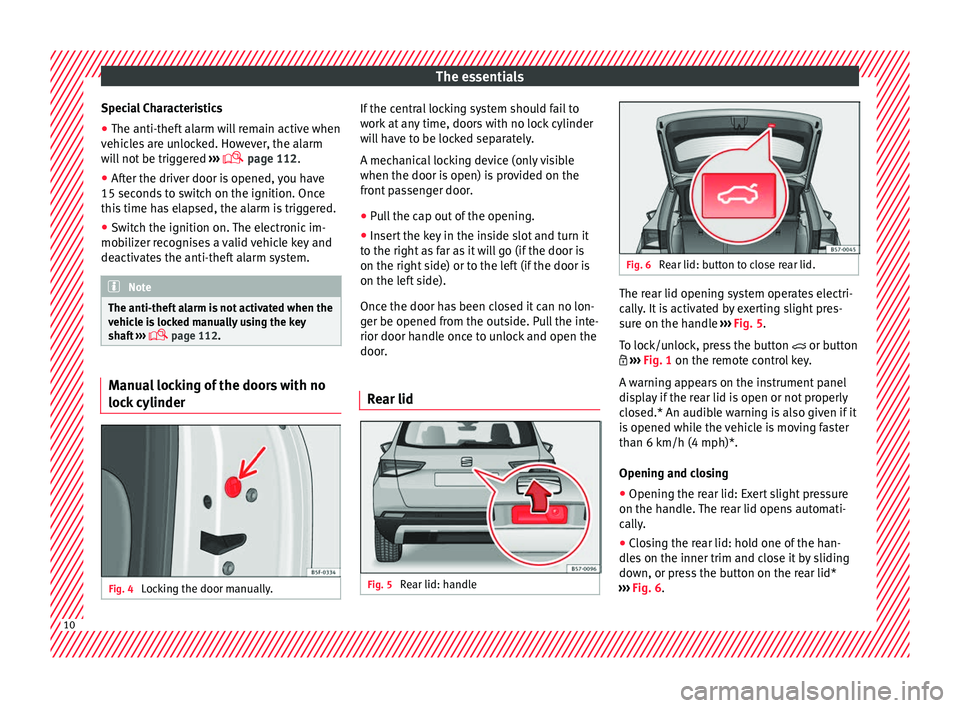
The essentials
Special Characteristics
● The anti-theft alarm will remain active when
v ehic
les are unlocked. However, the alarm
will not be triggered ›››
page 112.
● After the driver door is opened, you have
15 second
s to switch on the ignition. Once
this time has elapsed, the alarm is triggered.
● Switch the ignition on. The electronic im-
mob
ilizer recognises a valid vehicle key and
deactivates the anti-theft alarm system. Note
The anti-theft alarm is not activated when the
v ehic
le is locked manually using the key
shaft ›››
page 112. Manual locking of the doors with no
loc
k
cylinder Fig. 4
Locking the door manually. If the central locking system should fail to
w
ork
at any time, doors with no lock cylinder
will have to be locked separately.
A mechanical locking device (only visible
when the door is open) is provided on the
front passenger door.
● Pull the cap out of the opening.
● Insert the key in the inside slot and turn it
to the right
as far as it will go (if the door is
on the right side) or to the left (if the door is
on the left side).
Once the door has been closed it can no lon-
ger be opened from the outside. Pull the inte-
rior door handle once to unlock and open the
door.
Rear lid Fig. 5
Rear lid: handle Fig. 6
Rear lid: button to close rear lid. The rear lid opening system operates electri-
c
al
ly. It is activated by exerting slight pres-
sure on the handle ››› Fig. 5.
To lock/unlock, press the button or button
››› Fig. 1 on the remote control key.
A warning appears on the instrument panel
display if the rear lid is open or not properly
closed.* An audible warning is also given if it
is opened while the vehicle is moving faster
than 6 km/h (4 mph)*.
Opening and closing
● Opening the rear lid: Exert slight pressure
on the handl
e. The rear lid opens automati-
cally.
● Closing the rear lid: hold one of the han-
dle
s on the inner trim and close it by sliding
down, or press the button on the rear lid*
››› Fig. 6.10
Page 13 of 328
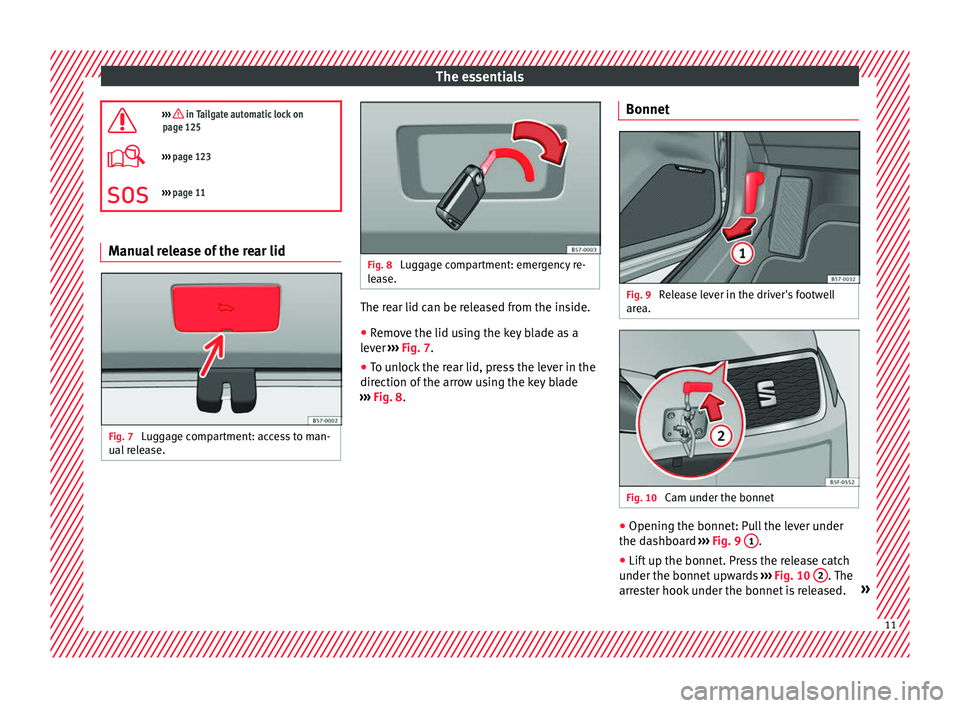
The essentials
››› in Tailgate automatic lock on
page 125
››› page 123
››› page 11 Manual release of the rear lid
Fig. 7
Luggage compartment: access to man-
ual r
elease. Fig. 8
Luggage compartment: emergency re-
l e
ase. The rear lid can be released from the inside.
●
Remove the lid using the key blade as a
l ev
er ››› Fig. 7.
● To unlock the rear lid, press the lever in the
direction of
the arrow using the key blade
››› Fig. 8. Bonnet Fig. 9
Release lever in the driver's footwell
ar e
a. Fig. 10
Cam under the bonnet ●
Opening the bonnet: Pull the lever under
the d a
shboard ››› Fig. 9 1 .
● Lift up the bonnet. Press the release catch
u nder the bonnet
upwards ››› Fig. 10 2 . The
arr e
ster hook under the bonnet is released. » 11
Page 14 of 328
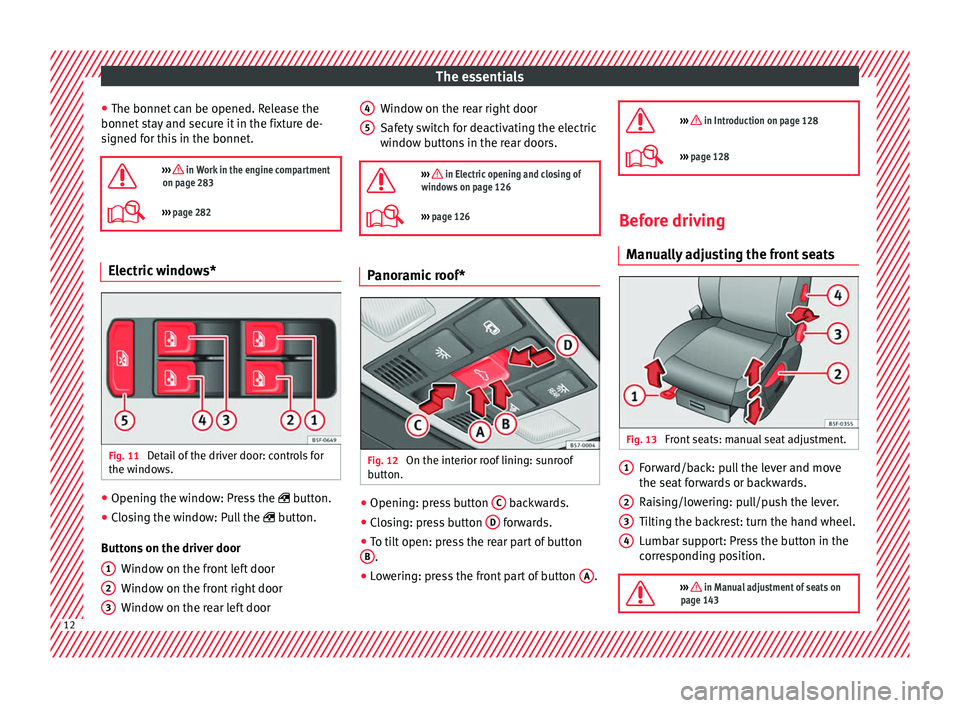
The essentials
● The bonnet c
an be opened. Release the
bonnet stay and secure it in the fixture de-
signed for this in the bonnet.
››› in Work in the engine compartment
on page 283
››› page 282 Electric windows*
Fig. 11
Detail of the driver door: controls for
the w indo
ws. ●
Opening the window: Press the butt
on.
● Closing the window: Pull the butt
on.
Buttons on the driver door Window on the front left door
Window on the front right door
Window on the rear left door
1 2
3 Window on the rear right door
Saf
ety
switch for deactivating the electric
window buttons in the rear doors.
››› in Electric opening and closing of
windows on page 126
››› page 126 Panoramic roof*
Fig. 12
On the interior roof lining: sunroof
b utt
on. ●
Opening: press button C backwards.
● Closing: press button D forwards.
● To tilt open: press the rear part of button
B .
● Lowering: press the front part of button A .
4 5
››› in Introduction on page 128
›››
page 128 Before driving
M anua
lly adjusting the front seats Fig. 13
Front seats: manual seat adjustment. Forward/back: pull the lever and move
the se
at
forwards or backwards.
Raising/lowering: pull/push the lever.
Tilting the backrest: turn the hand wheel.
Lumbar support: Press the button in the
corresponding position.
››› in Manual adjustment of seats on
page 143 1
2
3
4
12
Page 15 of 328
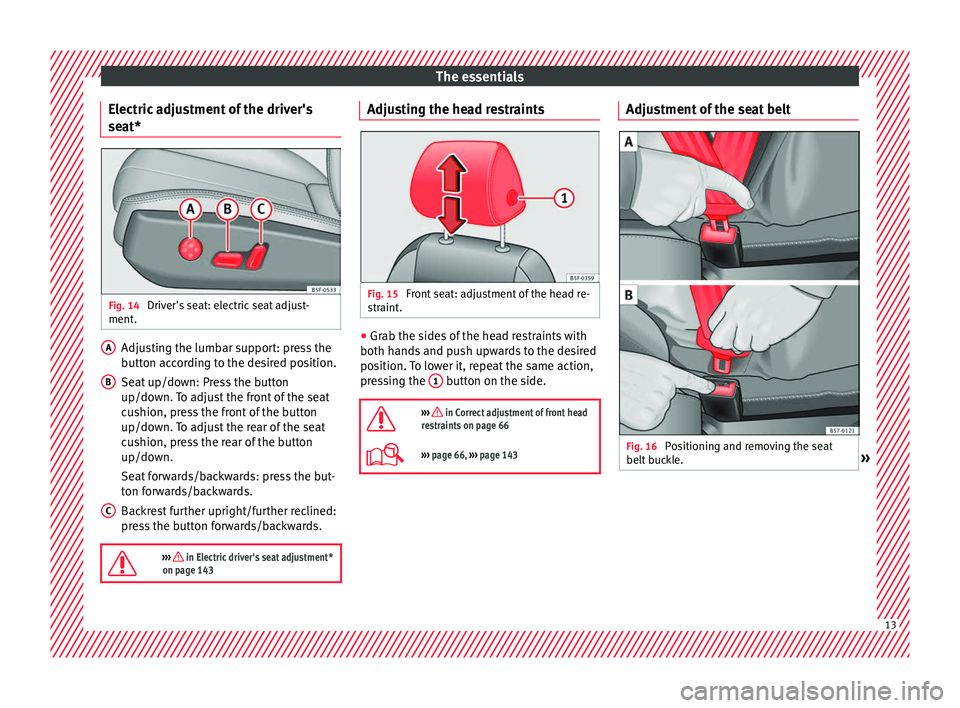
The essentials
Electric adjustment of the driver's
se at* Fig. 14
Driver's seat: electric seat adjust-
ment . Adjusting the lumbar support: press the
b
utt
on according to the desired position.
Seat up/down: Press the button
up/down. To adjust the front of the seat
cushion, press the front of the button
up/down. To adjust the rear of the seat
cushion, press the rear of the button
up/down.
Seat forwards/backwards: press the but-
ton forwards/backwards.
Backrest further upright/further reclined:
press the button forwards/backwards.
››› in Electric driver's seat adjustment*
on page 143 A
B
C Adjusting the head restraints
Fig. 15
Front seat: adjustment of the head re-
s tr
aint. ●
Grab the sides of the head restraints with
both h and
s and push upwards to the desired
position. To lower it, repeat the same action,
pressing the 1 button on the side.
››› in Correct adjustment of front head
restraints on page 66
››› page 66, ››› page 143 Adjustment of the seat belt
Fig. 16
Positioning and removing the seat
belt b
uckle. » 13
Page 16 of 328
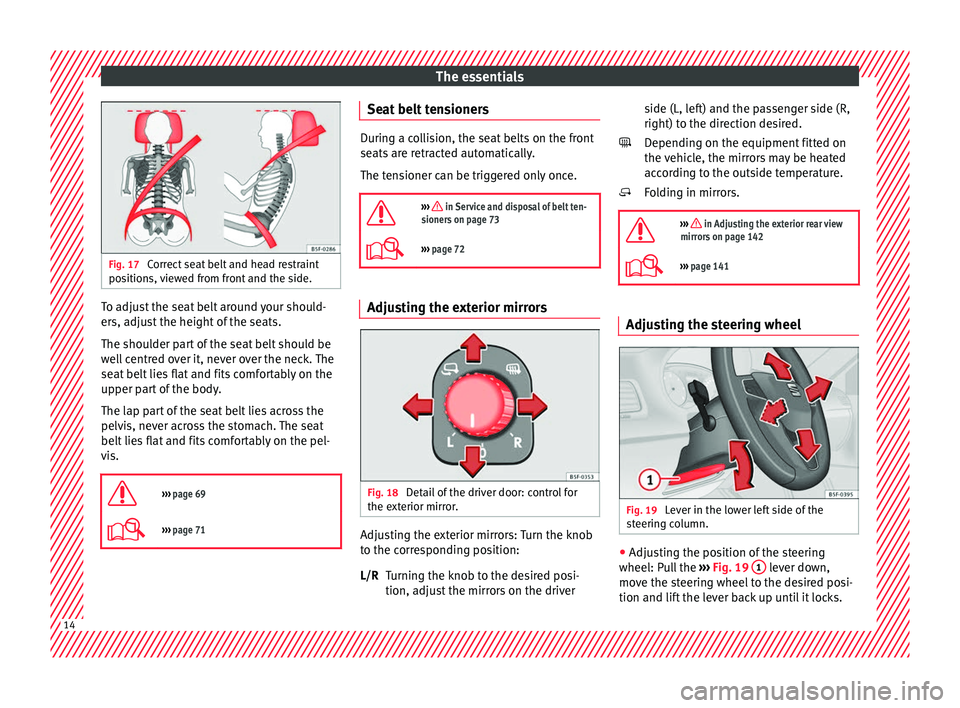
The essentials
Fig. 17
Correct seat belt and head restraint
po s
itions, viewed from front and the side. To adjust the seat belt around your should-
er
s, a
djust the height of the seats.
The shoulder part of the seat belt should be
well centred over it, never over the neck. The
seat belt lies flat and fits comfortably on the
upper part of the body.
The lap part of the seat belt lies across the
pelvis, never across the stomach. The seat
belt lies flat and fits comfortably on the pel-
vis.
››› page 69
››› page 71 Seat belt tensioners
During a collision, the seat belts on the front
se
ats
are retracted automatically.
The tensioner can be triggered only once.
››› in Service and disposal of belt ten-
sioners on page 73
››› page 72 Adjusting the exterior mirrors
Fig. 18
Detail of the driver door: control for
the e xt
erior mirror. Adjusting the exterior mirrors: Turn the knob
t
o the c
orresponding position:
Turning the knob to the desired posi-
tion, adjust the mirrors on the driver
L/R side (L, left) and the passenger side (R,
right) to the dir
ection desired.
Depending on the equipment fitted on
the vehicle, the mirrors may be heated
according to the outside temperature.
Folding in mirrors.
››› in Adjusting the exterior rear view
mirrors on page 142
››› page 141 Adjusting the steering wheel
Fig. 19
Lever in the lower left side of the
s t
eering column. ●
Adjusting the position of the steering
wheel: P u
ll the ››› Fig. 19 1 lever down,
mo v
e the steering wheel to the desired posi-
tion and lift the lever back up until it locks.
14
Page 17 of 328
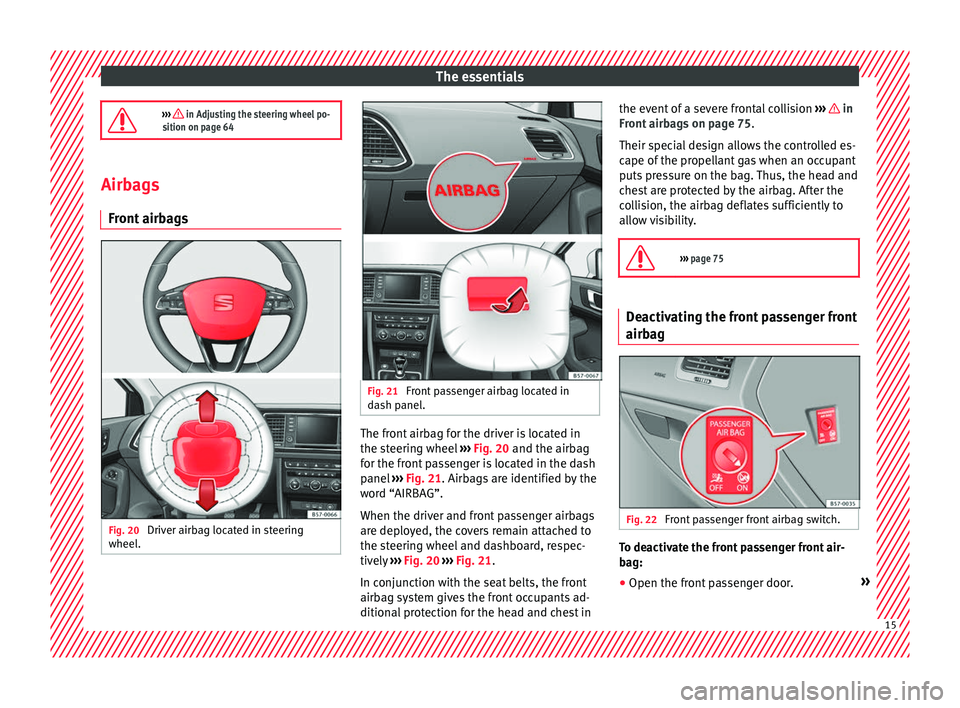
The essentials
››› in Adjusting the steering wheel po-
sition on page 64 Airbags
Front
airbags Fig. 20
Driver airbag located in steering
wheel . Fig. 21
Front passenger airbag located in
d a
sh panel. The front airbag for the driver is located in
the s
t
eering wheel ››› Fig. 20 and the airbag
for the front passenger is located in the dash
panel ››› Fig. 21. Airbags are identified by the
word “AIRBAG”.
When the driver and front passenger airbags
are deployed, the covers remain attached to
the steering wheel and dashboard, respec-
tively ››› Fig. 20 ››› Fig. 21.
In conjunction with the seat belts, the front
airbag system gives the front occupants ad-
ditional protection for the head and chest in the event of a severe frontal collision
››
› in
Fr ont
airbags on page 75.
Their special design allows the controlled es-
cape of the propellant gas when an occupant
puts pressure on the bag. Thus, the head and
chest are protected by the airbag. After the
collision, the airbag deflates sufficiently to
allow visibility.
››› page 75 Deactivating the front passenger front
airb
ag Fig. 22
Front passenger front airbag switch. To deactivate the front passenger front air-
b
ag:
● Open the fr
ont passenger door. » 15
Page 18 of 328
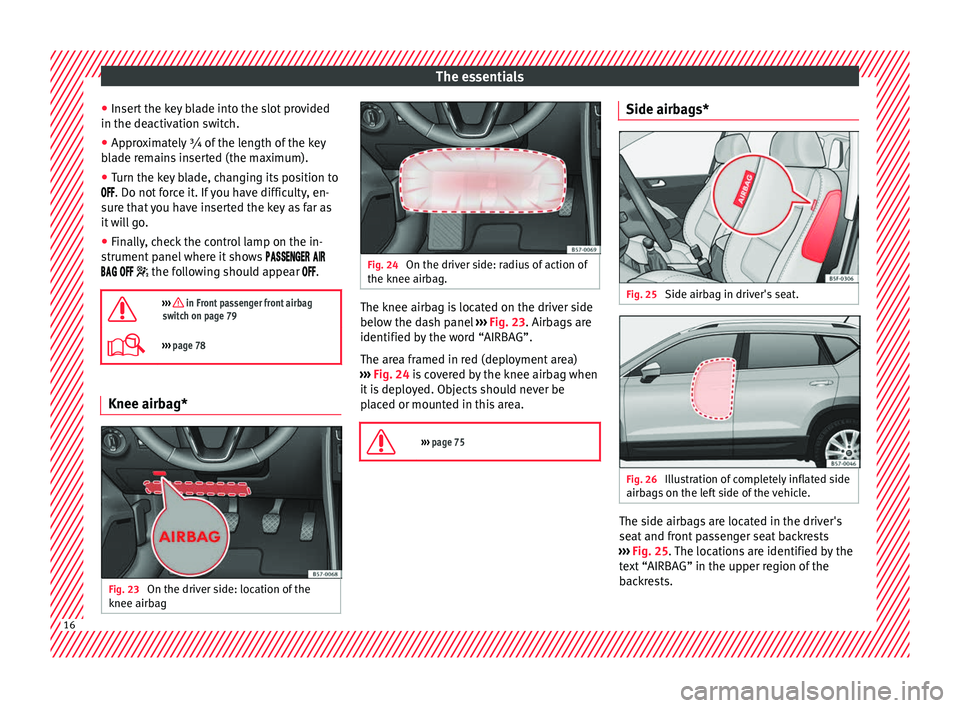
The essentials
● Inser
t the key blade into the slot provided
in the deactivation switch.
● Approximately ¾ of the length of the key
bl
ade remains inserted (the maximum).
● Turn the key blade, changing its position to
. Do not f
orce it. If you have difficulty, en-
sure that you have inserted the key as far as
it will go.
● Finally, check the control lamp on the in-
strument
panel where it shows
the following should appear .
››› in Front passenger front airbag
switch on page 79
››› page 78 Knee airbag*
Fig. 23
On the driver side: location of the
knee airb ag Fig. 24
On the driver side: radius of action of
the knee airb ag. The knee airbag is located on the driver side
belo
w the d
ash panel ››› Fig. 23. Airbags are
identified by the word “AIRBAG”.
The area framed in red (deployment area)
››› Fig. 24 is covered by the knee airbag when
it is deployed. Objects should never be
placed or mounted in this area.
››› page 75 Side airbags*
Fig. 25
Side airbag in driver's seat. Fig. 26
Illustration of completely inflated side
airb ag
s on the left side of the vehicle. The side airbags are located in the driver's
se
at
and front passenger seat backrests
››› Fig. 25. The locations are identified by the
text “AIRBAG” in the upper region of the
backrests. 16
Page 19 of 328
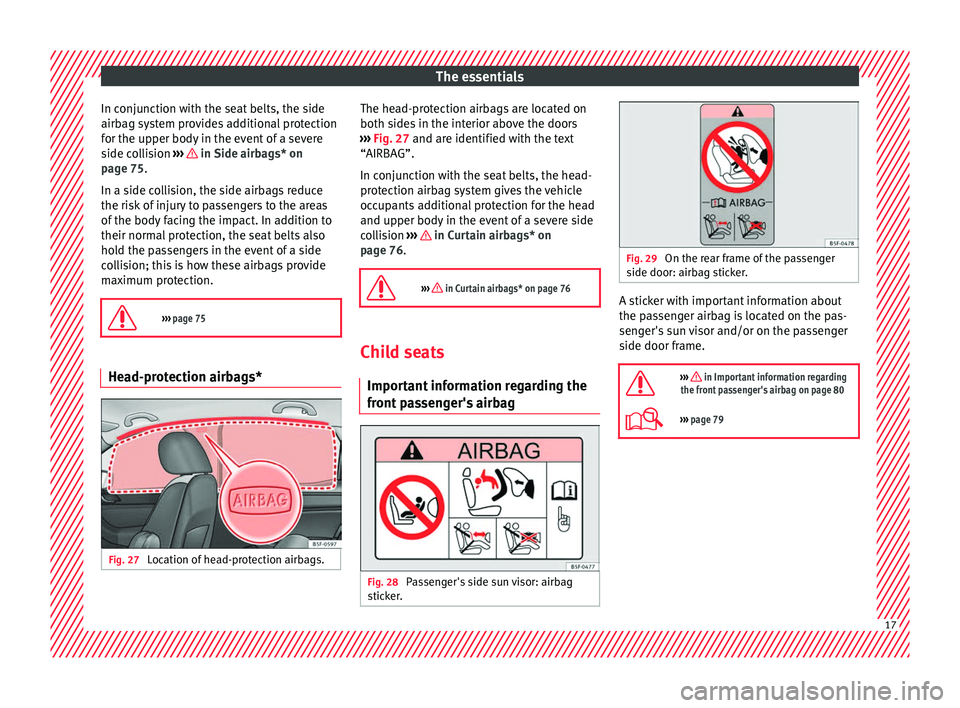
The essentials
In conjunction with the seat belts, the side
airb ag sy
stem provides additional protection
for the upper body in the event of a severe
side collision ››› in Side airbags* on
p ag
e 75.
In a side collision, the side airbags reduce
the risk of injury to passengers to the areas
of the body facing the impact. In addition to
their normal protection, the seat belts also
hold the passengers in the event of a side
collision; this is how these airbags provide
maximum protection.
››› page 75 Head-protection airbags*
Fig. 27
Location of head-protection airbags. The head-protection airbags are located on
both s
ide
s in the interior above the doors
››› Fig. 27 and are identified with the text
“AIRBAG”.
In conjunction with the seat belts, the head-
protection airbag system gives the vehicle
occupants additional protection for the head
and upper body in the event of a severe side
collision ››› in Curtain airbags* on
p ag
e 76.
››› in Curtain airbags* on page 76 Child seats
Impor t
ant information regarding the
front passenger's airbag Fig. 28
Passenger's side sun visor: airbag
s tic
ker. Fig. 29
On the rear frame of the passenger
s ide door: airb
ag sticker. A sticker with important information about
the p
a
ssenger airbag is located on the pas-
senger's sun visor and/or on the passenger
side door frame.
››› in Important information regarding
the front passenger's airbag on page 80
››› page 79 17
Page 20 of 328
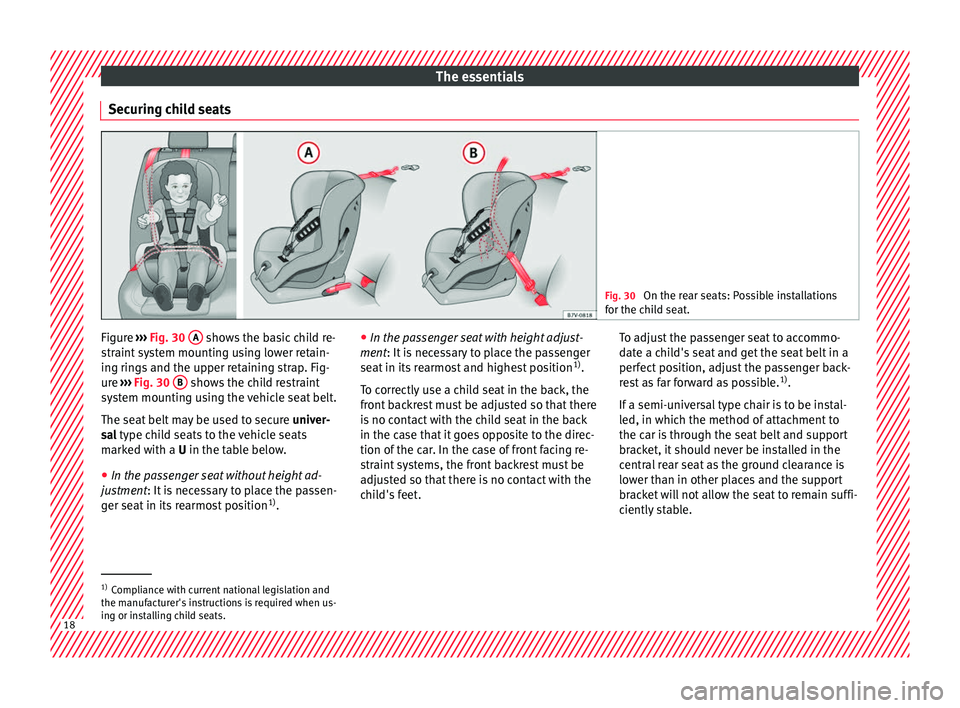
The essentials
Securing child seats Fig. 30
On the rear seats: Possible installations
f or the c
hild seat. Figure
›››
Fig. 30
A shows the basic child re-
s tr
aint system mounting using lower retain-
ing rings and the upper retaining strap. Fig-
ure ››› Fig. 30 B shows the child restraint
sy s
tem mounting using the vehicle seat belt.
The seat belt may be used to secure univer-
sal type child seats to the vehicle seats
marked with a U in the table below.
● In the passenger seat without height ad-
justmen
t: It is necessary to place the passen-
ger seat in its rearmost position 1)
. ●
In the pas
senger seat with height adjust-
ment: It is necessary to place the passenger
seat in its rearmost and highest position 1)
.
To correctly use a child seat in the back, the
front backrest must be adjusted so that there
is no contact with the child seat in the back
in the case that it goes opposite to the direc-
tion of the car. In the case of front facing re-
straint systems, the front backrest must be
adjusted so that there is no contact with the
child's feet. To adjust the passenger seat to accommo-
dat
e a child's seat and get the seat belt in a
perfect position, adjust the passenger back-
rest as far forward as possible. 1)
.
If a semi-universal type chair is to be instal-
led, in which the method of attachment to
the car is through the seat belt and support
bracket, it should never be installed in the
central rear seat as the ground clearance is
lower than in other places and the support
bracket will not allow the seat to remain suffi-
ciently stable. 1)
Compliance with current national legislation and
the m anuf
acturer's instructions is required when us-
ing or installing child seats. 18